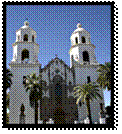
St. Augustine Cathedral (San Agustín)

Tucson in 1880

Modern Downtown Tucson
* Text by author, Gwen Harvey
Tucson Census |
|
| 1850 | 400 |
| 1855 | 600 – 700 |
| 1860 | 915 |
| 1870 | 3,224 |
| 1880 | 7,007 |
| 1890 | 5,120 |
| 1900 | 7,531 |
1870 Census Expanded |
||
| males | 1,920 | |
| females | 1,304 | |
| children | (385) | ages 6 – 16 |
| total population | 3,224 | |
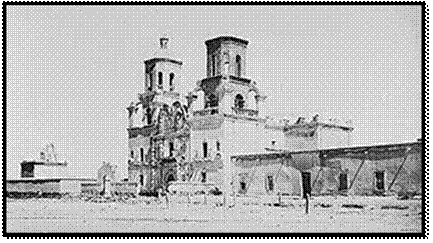
San Xavier Mission in 1887
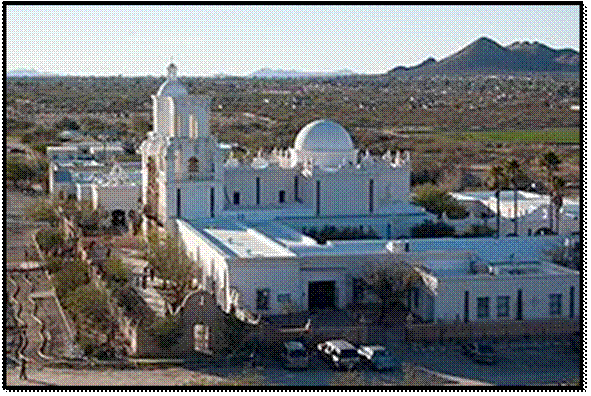
Modern San Xavier Mission

In Esperanza Means Hope, Alexander Levin was introduced as a guest at Señor Ochoa’s party. He is described as a “huge man with a bristling black beard and as a German Jewish immigrant … [who] ran Levin’s Park, one of Esperanza’s favorite places.” Esperanza dreamed of tasting the ice cream from the saloon, but she knew her family couldn’t afford it. Levin’s Park was also mentioned in the story as the site of the 1876 Centennial fireworks display in Tucson. Levin was a brewer by trade.
Levin’s Park is also worthy of some description, having been for many years a very popular resort in Tucson. Here the San Augustine fiestas were held, celebration of both American and Mexican independence, and was the scene of many a revelry (partying). It was the constant care and pride of Alexander Levin, who set out the rows of trees, and watched their growth from slender saplings to trees of great height and size; the entire area of the [seven acre] park was shaded by their foliage. He planted eucalyptus, pepper and cottonwood trees as well as many varieties of roses and other flowers.
Benches and tables were provided for the guests (in shady places), and refreshments furnished from a restaurant on the grounds. Levin was the first in town to introduce ice as a luxury item. A high fence made it safe from improper intrusion (disturbance), and a gatekeeper held the premises in charge. A skating rink, shooting gallery, bowling alley and dancing pavilion were prominent attractions. Levin built Park Hall with a 2000 seat capacity, to accommodate live theatre and operas. Music was discoursed (played) every evening by a first-class string band, and concerts every Sunday afternoon were much frequented. Its pleasant shade and cool breezes were blessings in this village on the Santa Cruz, and a visit to Tucson was not considered complete without taking in the old mission, Levin’s Park and Fort Lowell, which divided honors with the park as a resort for the social set of early timers.
![]()

penny licks glassware
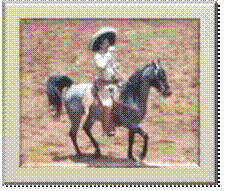
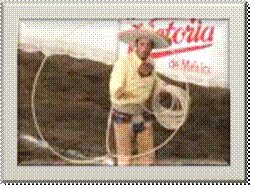
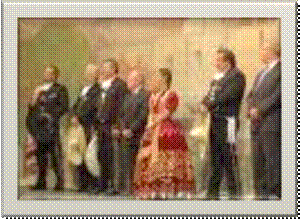
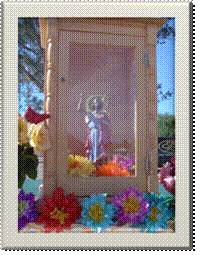
Three years later, the Sisters opened a school for Native American children at the San Xavier Mission.
| Esperanza describes San Juan’s Day on pages 42 – 43 in the book. Check to see if her description of the day matches the historic and modern day versions of the celebration. Make a Venn diagram noting similarities and differences between the historic celebration as described by Esperanza and the modern-day Tucson fiesta. Watch the video to help you. | How do Tucson residents receive water today? Click Tucson water and heritage to learn about the current municipal water system.  Then write down ten ways you can help conserve water in Arizona. View Water CASA Then write down ten ways you can help conserve water in Arizona. View Water CASA |
Use the center recipe and make Cinnamon Vanilla ice cream in a bag. You may wish to make more than one bag full in order to have enough to share with your friends. A “penny lick” might not be enough! |
| Learn more about one of early Tucson’s prominent male citizens and make a biographical poster about him. Choose from the center’s gallery of early Tucson citizens. See the Jacob Mansfield poster for an example. | Occasionally, a traveling circus or a Punch and Judy show entertained the people of Tucson. Learn about the Punch and Judy shows and share your learning as an oral report to other students.
|
Father Eusebio Kino founded the San Xavier Mission, located on the Tohono O’odham Reservation. Research Padre Kino and write a brief biographical sketch about him and his missionary work in Primeria Alta as southern Arizona was known during Spanish rule. |

